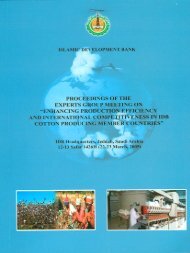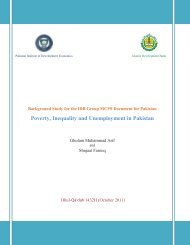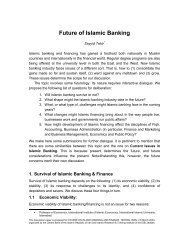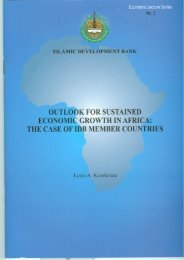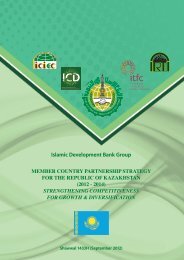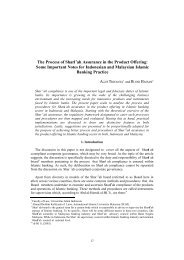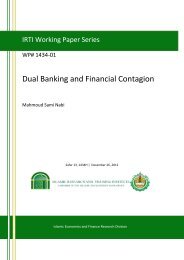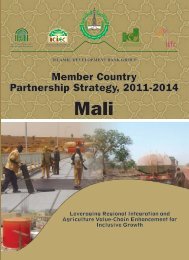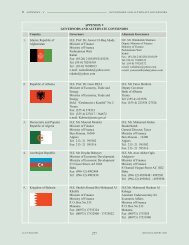Country Economic Work for Malaysia - Islamic Development Bank
Country Economic Work for Malaysia - Islamic Development Bank
Country Economic Work for Malaysia - Islamic Development Bank
You also want an ePaper? Increase the reach of your titles
YUMPU automatically turns print PDFs into web optimized ePapers that Google loves.
ole in spearheading economic development. The Government demonstrated strong<br />
commitment to the public-private collaboration. In the early years, it took some time <strong>for</strong><br />
Government Departments and Agencies to work closely with the private sector. With greater<br />
appreciation of the need <strong>for</strong> close cooperation, the collaborative environment between public<br />
and private sectors has improved over the years. Strong commitment and conscious ef<strong>for</strong>ts<br />
made by the Government to encourage consultative panels to invigorate their activities have<br />
substantially contributed to the effective operationalisation of the MIC over the years. The<br />
Government has played a key role in delivering high quality services and has increased its<br />
interaction with the private sector. This was further complemented by specific measures to<br />
intensify training of the middle and lower level functionaries of the Government to enhance<br />
their understanding on the MIC and bring about a positive change in their mindset and<br />
attitude. Further, the planned, coordinated and coherent manner in which the Government<br />
went about implementing the policy also contributed to MIC success.<br />
87. The fruits of <strong>Malaysia</strong>’s pioneering privatisation drive are now increasingly<br />
evident. Several corporatized and privatised Government Linked Companies (GLCs) as well<br />
as private firms have become large market cap companies on Bursa <strong>Malaysia</strong> (Kuala Lumpur<br />
Stock Exchange) and have successfully ventured abroad and are now emerging as <strong>Malaysia</strong>n<br />
Multinational Companies (MNCs). The privatisation programme has also elicited a surge of<br />
<strong>for</strong>eign interests in <strong>Malaysia</strong>’s stock markets. The depth and variety that privatisation brought<br />
to the stock market had also contributed to the more rapid development of <strong>Malaysia</strong>’s<br />
financial and capital markets.<br />
88. As a way <strong>for</strong>ward, <strong>Malaysia</strong>’s Vision 2020 is to lift the country to an accelerated<br />
growth path towards a high income economy and developed nation status through<br />
supporting effective PPP. Through active participation of the private sector, the<br />
Government’s policies and resources are being channelled towards driving the economy<br />
<strong>for</strong>ward. In particular, during the challenging global economic environment, economic<br />
recovery cannot be engineered by the Government alone. It is only possible through the<br />
combined ef<strong>for</strong>ts of the private sector and the Government, that <strong>Malaysia</strong> will be able to<br />
achieve Vision 2020 targets. Towards this end, the Tenth <strong>Malaysia</strong> Plan embraces a new<br />
economic model, necessary <strong>for</strong> their trans<strong>for</strong>mation into a high income country. In<br />
encapsulating the policy direction and developmental priorities <strong>for</strong> <strong>Malaysia</strong>’s trans<strong>for</strong>mation<br />
ahead, a key thrust that the Plan will be <strong>for</strong>ging is effective public private partnerships,<br />
mainly through establishing five “Growth <strong>Economic</strong> Corridors”, which are described briefly<br />
below.<br />
Growth <strong>Economic</strong> Corridors: balanced regional growth through PPPs<br />
89. With commitment to bring balanced regional growth, the Government of<br />
<strong>Malaysia</strong> established five economic growth corridors namely Northern Corridor <strong>Economic</strong><br />
Region; Eastern Corridor <strong>Economic</strong> Region; Iskandar <strong>Malaysia</strong>; Sarawak Corridor of<br />
Renewable Energy; and Sabah <strong>Development</strong> Corridor under the Ninth <strong>Malaysia</strong> Plan (Figure<br />
5.4). These corridors are aimed at bridging development imbalances throughout the country<br />
and have been pushing <strong>for</strong>ward the country's economic growth through public private<br />
partnerships in these regions. Further, disperse economic activities across states to spread<br />
benefits from development Cluster- and corridor-based economic activities with focus areas<br />
are being carried out mainly by the PPP, which are described briefly below.<br />
41







